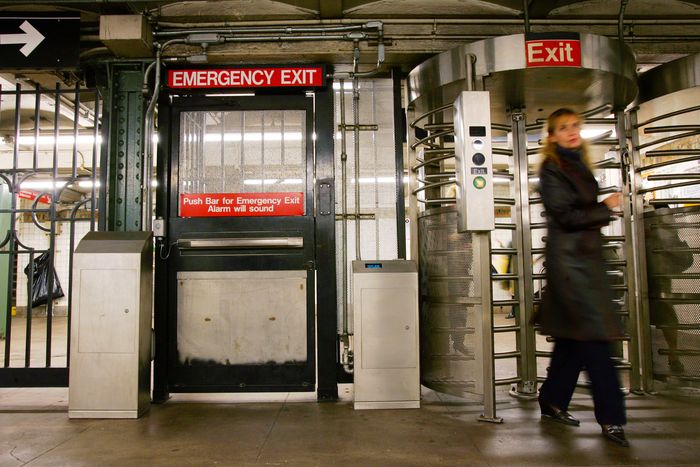
Photo: Ron Antonelli/NY Daily News via Getty Images
When most New Yorkers picture fare evasion, they likely imagine the balletic leap of a nimble high-schooler over a glinting turnstile. What they should be picturing is me: a schlubby 37-year-old white lady coated in a thin layer of cat fur, wheeling a stroller through the emergency-exit door. Cost to taxpayers: $5.50, because I also convinced someone on the other side of that emergency-exit gate to push it open for me. For free.
On Tuesday, the MTA’s CEO, Janno Lieber, went on 1010 WINS, where he described exit doors as the “superhighway for fare evasion,” capable of “contributing to this sense of disorder in the system” and “destructive to the sense of fairness and fair play that animates New York.” Forgetting that a man who makes more than $300,000 a year considers New York to have a “sense of fairness,” and ignoring a mischaracterization of anything related to the subway as a “superhighway,” I am here to take issue with what Lieber said next: that the MTA plans to redesign those exit doors, and the turnstiles next to them, to prevent fare evasion.
But for parents like me, those wide, heavy doors are actually the only thing working in a hellscape of broken elevators and late trains. And they connect us to a kind, like-minded community of New Yorkers who see our suffering; who know intuitively to open the door for a dad pushing a stroller, a grandma pulling a grandma cart, a group of college students attempting to move an Ikea couch via subway.
The MTA seems to teach parents to skirt its rules. Some stations do have accessible doors — with an attached card reader, programmed to swing the door open. But others expect stroller users to abandon a child at the door, head to a turnstile, and come back around from the other side, hoping child services doesn’t find them first. “It feels more wrong to leave your kid in a stroller on one side of an exit door,” says Lane Rick, an architect and mother of a 2-year-old, who prefers standing at the door and simply waiting for some kind soul to push the bar and let her in. (Cost to taxpayers: $2.75.) The second, legal way in is to catch the eye of a station agent who has access to a mysterious button capable of popping the door open. But the MTA has been cutting costs by cutting those workers. When they are there, they’re sometimes absorbed in helping someone. And catching their eye is a lot easier if you look like me — a stereotypical white-lady mom.
“The whole thing makes you feel horrible. I’d been a subway rider my whole life, and then I had kids and realized how unwelcome you are on there,” says Danielle Avissar, a mother who fought the MTA to allow strollers on buses, which the agency is now testing in a pilot program. “New York is the most progressive city in the country? But for this to be a norm? It’s insane.”
The MTA’s focus on making it harder to get on trains — instead of easier — irks the activists who have been pressuring the agency to become 100 percent accessible. Jennifer Van Dyck, with the Elevator Action Group, called the focus on gates “insulting”: “It is about priorities, and their priorities are pretty cockeyed at the moment.”
In his radio interview, Lieber didn’t suggest earning more riders by improving accessibility. He seemed to suggest a move toward inaccessibility. He called the doors “too porous.” “They’re letting a lot of people in, and we have to have a different physical barrier to stop people from doing this,” he said.
To me, toying with the doors I can depend on, and clamping down on the friendly New Yorkers who hold them open, would be “destructive to the sense of fairness and fair play that animates New York.” At least to my New York.
"Exit" - Google News
December 07, 2022 at 10:19PM
https://ift.tt/SdG4x9r
Ode to the Subway Exit Gate - Curbed
"Exit" - Google News
https://ift.tt/zAxIhCg
https://ift.tt/g89YDA7
Bagikan Berita Ini














0 Response to "Ode to the Subway Exit Gate - Curbed"
Post a Comment